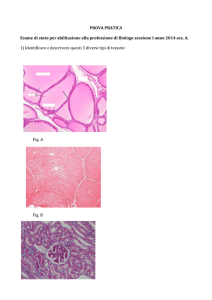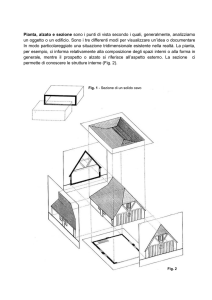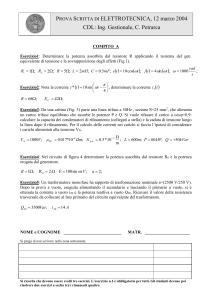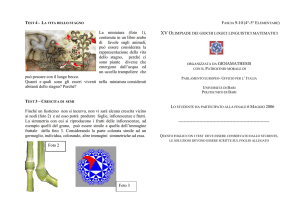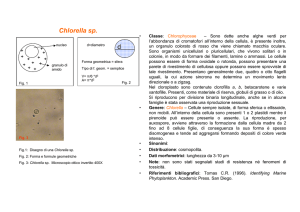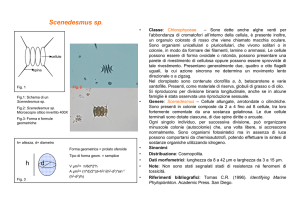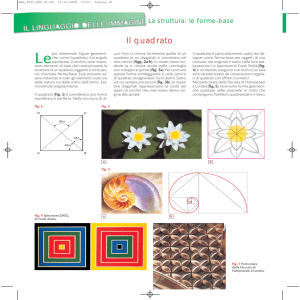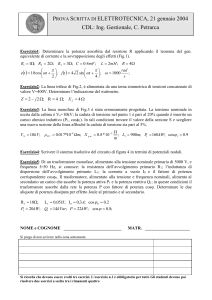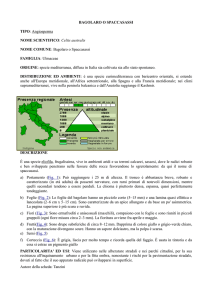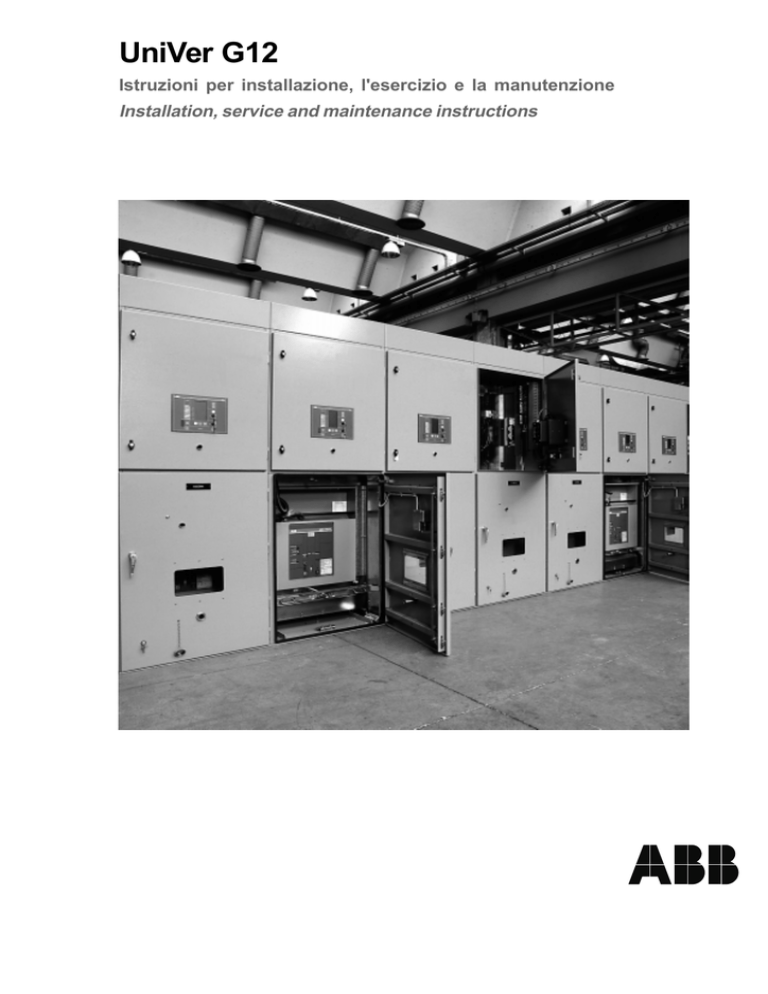
UniVer G12
Istruzioni per installazione, l'esercizio e la manutenzione
Installation, service and maintenance instructions
Contents
Indice
1
Descrizione
1.1 Generalità
1.1.1 Caratteristiche funzionali
1.1.2 Caratteristiche elettriche
1.1.3 Rispondenza alle norme
1.1.4 Costruzione dello scomparto base
1.2 Blocchi
1.2.1 Sull'interruttore
1.2.2 Sul sezionatore di terra
1.2.3 Sulla porta posteriore cella linea
1.3 Manovre normali
1.3.1 Sull'interruttore
1.3.2 Sul sezionatore di terra
1.3.3 Sulla porta posteriore cella linea
1.4 Manovre di emergenza
1.4.1 Sull'interruttore
1.4.2 Sull'apertura del sezionatore di terra
1.4.3 Sulla porta posteriore cella linea
1.4.4 Sulla porta della cella interruttore
1.5 Accessori di normale fornitura
2
Installazione
2.1 Controllo a ricevimento
2.1.1 Imballaggio
2.1.2 Controllo
2.2. Magazzinaggio
2.3 Sollevamento scomparti
2.4 Fondazioni
2.4.1 Foratura soletta
2.4.2 Fissaggio scomparti a pavimento
senza ferri di base
2.4.3 Fiassaggio scomparti a pavimento
con ferri di base
2.5 Accoppiamento scomparti
2.6 Collegamenti principali
2.6.1 Sbarre omnibus tubolari
2.6.2 Sbarre omnibus piatte
2.6.3 Sbarre di terra
2.6.4 Collegamento cavi
2.7 Collegamenti secondari
2.8 Controllo prima delle prove
2.9 Prove meccaniche
2.9.1 Sull'interruttore
2.9.2 Sul sezionatore di terra
2.10 Regolazioni
2.10.1 Sulla chiusura del sezionatore di terra
2.10.2 Sul blocco tra sezionatore di terra
e interruttore
2.11 Prove elettriche
2.11.1 Resistenza di isolamento
2.11.2 Isolamento a frequenza industriale
2.11.3 Funzionalità
2.12 Messa in servizio
3
3.1
3.2
3.3
3.4
Manutenzione
Frequenza di ispezione
Operazione di sicurezza
Operazioni di manutenzione
Ripristino del servizio
Pag.
2
2
2
2
2
2
3
3
3
3
4
4
4
4
4
4
4
5
5
5
6
6
6
6
6
6
7
7
7
7
8
8
8
9
10
10
10
10
11
11
11
11
11
11
11
11
11
12
12
12
12
12
12
12
1
Description
1.1 General
1.1.1 Operating characteristics
1.1.2 Electrical characteristics
1.1.3 Compliance with standards
1.1.4 Make-up of the basic cubicle
1.2 Locks
1.2.1 On the circuit-breaker
1.2.2 On the earthing switch
1.2.3 On the feeder compartment rear door
1.3. Normal operations
1.3.1 On the circuit breaker
1.3.2 On the earthing switch
1.3.3 On the feeder compartment rear door
1.4 Emergency operations
1.4.1 On the circuit-breaker
1.4.2 On the earthing switch
1.4.3 On the feeder compartment rear door
1.4.4 On the door of the circuit-breaker
compartment
1.5 Accessories supplied as standard
2
Installation
2.1 Checking on receipt
2.1.1 Packing
2.1.2 Inspection
2.2 Storage
2.3 Cubicle lifting
2.4 Foundations
2.4.1 Slab drilling
2.4.2 Fixing cubicles to the floor without
base irons
2.4.3 Fixing cubicles to the floor with base irons
2.5 Coupling cubicles
2.6 Main connections
2.6.1 Tubular omnibus busbars
2.6.2 Flat omnibus busbars
2.6.3 Earthing busbars
2.6.4 Cable connection
2.7 Auxiliary connections
2.8 Checking before tests
2.9 Mechanical tests
2.9.1 On the circuit breaker
2.9.2 On the earthing switch
2.10 Adjustments
2.10.1 On closure of the earthing switch
2.10.2 On lock between earthing switch and
circuit-breaker
2.11 Electrical tests
2.11.1 Insulation resistance
2.11.2 Insulation at industrial frequency
2.11.3 Functionality
2.12 Service
3
Maintenance
3.1 Inspection intervals
3.2 Safety operation
3.3 Maintenance operations
3.4 Putting back into service
Page
2
2
2
2
2
2
3
3
3
3
4
4
4
4
4
4
4
5
5
5
6
6
6
6
6
6
7
7
7
7
8
8
8
9
10
10
10
10
11
11
11
11
11
11
11
11
11
12
12
12
12
12
12
12
1
1
1
Descrizione
Description
1.1 Generalità
1.1 General
I quadri Univer G12 vengono costruiti con l'impiego di contenitori che possono ricevere interruttori serie Esafluor HA tipo
HA1 SG, HA2 SG, HA3 NF/sG.
Univer G12 switchboards are constructed using enclosures
which can take Esafluor HA series circuit-breakers type HA1,
SG, HA2, SG, HA3 NF/sG.
1.1.1 Caratteristiche funzionali
– Massima continuità di servizio
– Sicurezza per il personale
– Sicurezza contro l'incendio
– Semplicità di manutenzione e di ispezione
– Manovrabilità
– Versatilità e flessibilità
1.1.1 Operating characteristics
– Maximum service continuity
– Personnel safety
– Safety against fire
– Simple maintenance and inspection
– Easy handling
– Versatility and flexibility
1.1.2 Caratteristiche elettriche
– Tensione nominale
– Tensione di prova a 50 Hz per 1 min.
– Tensione di tenuta ad impulso
– Corrente nominale delle sbarre
– Corrente termica ammissibile 1sec.
– Corrente dinamica (valore di cresta)
1.1.2 Electrical characteristics
– Rated voltage
12 kV
– Test voltage at 50 Hz for 1 min.
28 kV
– Impulse withstand voltage
75 kV
– Rated busbar current
from 1250 to 3600 A
– Short-time withstand current (1 sec.) up to 50 kA
– Momentary current (peak value)
up to 125 kA
12 kV
28 kV
75 kV
da 1250 a 3600A
fino 50 kA
fino 125 kA
1.1.3 Rispondenza alle norme
– CEI italiane 17-6 (fasc. 2056)
– IEC internazionali 298
– Leggi antiinfortunistiche italiane (DPR 547)
1.1.3 Compliance with Standards
– Italian CEI 17-6 (file 2056)
– International IEC 298
– Italian Accident Prevention Laws (DPR 547)
1.1.4 Costituzione dello scomparto base (fig. 1 - fig. 2)
– A: cella strumenti
– B: contenitore
– C: cella linea
– D: cella sbarre
– E: cella TV (eventuale)
– F: condotto cavetti ausiliari esterni (eventuale)
1.1.4 Make-up of the basic cubicle (fig. 1 - fig. 2)
– A: instrument compartment
– B: enclosure
– C: feeder compartment
– D: busbars compartment
– E: VT compartment (if provided)
– F: external auxiliary cable duct (if provided)
F
E
A
C
B
D
Fig. 1
2
F
E
A
C
B
D
Consultare le istruzioni del contenitore 601829
See the instructions bnook of the enclosure 601829
Fig. 2
1.2 Blocchi
1.2 Locks
Vengono elencati i blocchi più comuni che possono comparire
nel quadro; quelli contraddistinti con (N) sono in normale
fornitura mentre quelli contraddistinti con (R) sono forniti solo a
richiesta.
The most common locks which can be fitted in the switchboard
are listed. Those marked (N) are standard supply, whereas
those marked (R) are only supplied on request.
1.2.1 Sull'interruttore
a) Impedisce l'inserzione se è chiuso l'eventuale sezionatore
di terra (N).
– Per gli altri blocchi consultare le istruzioni del contenitore.
1.2.1 On the circuit-breaker
a) Prevents connection if an earthing switch (N) provided is
closed
– For the other locks, please consult the instructions for the
enclosure.
1.2.2 Sul sezionatore di terra
a) Impedisce la chiusura se non viene disattivato il blocco
elettrico e/o a chiave (R).
b) Impedisce la chiusura se l'interruttore è inserito (N).
c) Impedisce l'apertura se non è stata chiusa la porta posteriore cella linea (N).
1.2.2 On the earthing switch
a) Prevents closure unless the electrical and/or key lock (R) is
inactivated.
b) Prevents closure if the circuit-breaker is connected (N)
c) Prevents opening unless the feeder compartment rear door
(N) has been closed.
1.2.3 Sulla porta posteriore cella linea
a) Impedisce l'apertura se non è chiuso il sezionatore di terra
(N).
1.2.3 On the feeder compartment rear door
a) Prevents opening unless the earthing switch (N) is closed.
3
1.3 Manovre normali
1.3 Normal operations
1.3.1 Sull'interruttore
a) Inserzione: prima di effettuare la manovra, verificare che sia
disattivato il blocco descritto al punto 1.2.1 e quanto descritto nelle istruzioni del contenitore.
b) Sezionamento: per passare dalla posizione di inserito a
quella di sezionato verificare che l'interruttore sia aperto.
1.3.1 On the circuit-breaker
a) Connection: before carrying out the operation, check that
the lock described in point 1.2.1 is inactivated and that the
instructions for the enclosure are followed.
b) Isolation: to pass from the connected to isolated position,
check that the circuit-breaker is open.
1.3.2 Sul sezionatore di terra
a) Azionamento: la leva di comando (fig. 3a) una volta introdotta nella propria sede (fig. 3b) e iniziata la sua rotazione,
rimane vincolata fino a quando non è stata completata la
manovra; dopo di che viene espulsa per effetto di una molla.
Se non si riesce a introdurre la maniglia vuol dire che manca
il consenso dei blocchi citati al punto 1.2.2.
b) Blocco a chiave: introdurre la chiave nella serratura (fig. 3c)
e ruotarla in senso orario di circa 90°quindi introdurre la leva
di manovra (fig. 3a).
c) Chiusura sezionatore: verificare che siano disattivati i blocchi previsti al punto 1.2.2; inserire la leva di manovra (fig. 3a)
e ruotare di 180° in senso antiorario.
d) Apertura sezionatore: verificare che siano disattivati i blocchi previsti al punto 1.2.2; inserire la leva di manovra (fig. 3a)
e ruotare di 180° in senso orario.
1.3.2 On the earthing switch
a) Activation: once the operating lever (fig. 3a) has been
inserted in its seat (fig. 3b) and its rotation started, it remains
locked until the operation has been completed. After this, it
is ejected by means of a spring.
If the lever cannot be inserted, it means that consent of the
lock mentioned in point 1.2.2 is missing.
b) Key lock: Insert the key in the lock (fig. 3c) and turn it about
90° clockwise, then insert the operating lever (fig. 3a).
c) Earthing switch closure: check that the locks mentioned in
point 1.2.2 are inactivated. Insert the operating lever (fig.
3a) and turn it 180° clockwise.
d) Earthing switch opening: check that the interlocks of point
1.2.2 give the consent; insert the operating lever (fig. 3a)
and turn clockwise of 180°.
1.3.3 Sulla porta posteriore cella linea
a) Apertura: verificare che sia disattivato il blocco descritto al
punto 1.2.3 (sezionatore di terra chiuso) e ruotare la maniglia in senso antiorario.
1.3.3 On the feeder compartment rear door
a) Opening: check that the lock described in point 1.2.3
(earthing switch closed) is inactivated, and turn the lever
anticlockwise.
1.4 Manovre di emergenza
1.4 Emergency operations
Le manovre qui sotto descritte devono essere eseguite esclusivamente in caso di assoluta necessità da personale qualificato che ne assume tutta la responsabilità. ABB SACE declina la
propria responsabilità circa le conseguenze che possono derivare da un eventuale errata manovra.
The operations described below must only be carried out in
case of absolute necessity and by qualified personnel who take
full responsibility for them. ABB SACE declines all responsibility
for any consequences due to incorrect operation.
1.4.1 Sull'interruttore
a) Consultare le istruzioni del contenitore
1.4.1 On the circuit-breaker
a) Consult the instructions for the enclosure
1.4.2 Sull'apertura del sezionatore di terra
a) Qualora si voglia effettuare l'apertura con la porta posteriore
aperta premere a fondo il perno di blocco (fig. 4a) e
contemporaneamente inserire la leva di comando come
scritto al punto 1.3.2.
1.4.2 On earthing switch opening
a) When opening must be carried out with the rear door open,
press the locking pin (fig. 4a) in fully and at the same time
insert the operating lever as described in point 1.3.2.
a
a
b
c
Fig. 3
4
Fig. 4
1.4.3 Sulla porta posteriore cella linea
a) Qualora si voglia aprire la porta (fig. 5) con sezionatore di
terra aperto ruotare con utensile la vite di sbocco (fig. 5a) di
circa 90° in senso orario e contemporaneamente ruotare la
maniglia ed aprire la porta.
1.4.3 On the feeder compartment rear door
a) When the door (fig. 5) must be opened with the earthing
switch open, turn the release screw (fig. 5a) about 90°
clockwise using the tool, turning the handle at the same
time, and open the door.
1.4.4 Sulla porta della cella interruttore
a) Qualora si voglia aprire la porta anteriore equipaggiata con
blocco elettrico, asportare la vite M10 a testa bombata dalla
porta, inserire il cacciavite (fig. 6) manovrarlo con attenzione, senza forzare, in senso orizzontale in caso di contenitori
Univer G ed in senso verticale in caso di contenitori
Univer G con HA3/NF/SG. Contemporaneamente a questa
manovra ruotare la maniglia e aprire la porta.
1.4.4 On the circuit-breaker compartment door
a) When the front door fitted with electric lock must be opened,
remove the round-headed M10 screw from the door, insert
the screwdriver (fig. 6), handling it carefully and without
forcing it, horizontally for Univer G enclosures and vertically
for Univer G enclosures with HA3/NF/SG. At the same time
as this operation, turn the handle and open the door.
a
Fig. 5
Fig. 6
1.5 Accessori di normale fornitura (fig. 7)
1.5 Accessories supplied as standard (fig. 7)
a) Piastra per l'inserzione e il sezionamento dell'interruttore
b) Leva di manovra per l'inserzione e il sezionamento dell'interruttore
c) Leva di comando del sezionatore di terra
d) Golfari di sollevamento degli scomparti
e) Mensole di supporto delle varie leve e maniglie
f) Manovella per la carica delle molle di comando
g) Vaschetta per scarico olio interruttori (per ricambio olio)
h) Recipiente per riempimento olio nei poli dell'interruttore.
a) Plate for connection and isolation of the circuit-breaker
b) Operating lever for connection and isolation of the circuitbreaker
c) Operating lever of the earthing switch
d) Cubicle lifting eyebolts
e) Support brackets for the various levers and handles
f ) Crank for charging the operating mechanism springs
g) Pan for draining circuit-breaker oil (to replace the oil)
h ) Container for filling the circuit-breaker poles with oil.
Fig. 7
5
2
2
Installazione
Installation
2.1 Controllo a ricevimento
2.1 Checking on receipt
2.1.1 Imballaggio
– Ogni quadro viene imballato in tante casse robuste di legno
contenenti uno o più scomparti dentro ai quali sono fissati gli
interruttori.
In altre casse vengono raggruppati tutti i materiali necessari
per:
– accoppiamento degli scomparti
– fissaggio a pavimento
– montaggio sbarre omnibus
– montaggio sbarra collettrice di terra
– accessori di manovra
2.1.1 Packing
– Each switchboard is packed in several sturdy wooden crates
containing one or more cubicles, onto which the circuitbreakers are fixed.
All the materials required for the following are grouped
together in other crates:
– cubicle coupling
– fixing to the floor
– fixing to the floor
– assembly of omnibus busbars
– operating accessories
2.1.2 Controllo
Disimballare facendo attenzione a non danneggiare il materiale
e controllare il suo stato di conservazione. Qualora venisse
riscontrato qualche danno o irregolarità nella fornitura, è necessario avvisare ABB SACE al più presto possibile ed in ogni caso
entro 5 giorni dal ricevimento del materiale.
2.1.2 Inspection
Unpack taking care not to damage the goods and check that
they are in good condition. Should any damage or irregularity
be noted in the supply, ABB SACE must be notified as soon as
possible and in any case within 5 days of receipt of the goods.
2.2 Magazzinaggio
2.2 Storage
Immagazzinare in luogo asciutto non polveroso privo di
agenti chimici aggressivi; in particolare non si devono mai
verificare condizioni che possano facilitare il fenomeno
della condensazione. Nel dubbio riscaldare eventualmente
l'ambiente. Nel caso il quadro rimanga temporaneamente in un
ambiente non esente da polvere, deve essere opportunamente
protetto con teli o fogli di plastica.
Store in a dry, dust-free place free from any aggressive
chemical agents. In particular, any conditions leading to
condensation must be avoided. When in doubt, heat the
room. Should the switchboard remain temporarily in a dusty
place, it must be suitably protected with tarpaulins or plastic
sheets..
2.3 Sollevamento scomparti
2.3 Cubicle lifting
Seguire scrupolosamente la seguente sequenza:
1) Inserire gli appositi golfari di sollevamento (fig. 8a) nelle
cave contrassegnate da targhette autodesive (fig. 8b).
2) Assicurare i golfari contro lo sfilamento tenendoli spinti
verso l'alto e avvitando la vite di posizionamento (fig. 9a).
3) Agganciare la grù e sollevare l'unità (fig. 10).
È sconsigliabile far scorrere gli scomparti su rulli di tubo perché
potrebbero danneggiare le basi degli scomparti.
Follow the sequence below very carefully:
1) Insert the special lifting eyebolts (fig. 8a) in the slots marked
with self-adhesive labels (fig. 8b)
2) Prevent the eyebolts from slipping out by keeping them
pushed upwards and by tightening the positioning screw
(fig. 9a).
3) Hook up to the crane and lift the unit (fig. 10).
It is not advisable to slide the cubicles on tube rollers since this
could damage the bases of the cubicles.
b
a
a
b
Fig. 8
Fig. 9
Fig. 10
6
2.4 Fondazioni
2.4 Foundations
Il quadro è costruito accuratamente con basi metalliche perfettamente piane per assicurare una facile inserzione ed estrazione dell'interruttore; occorre quindi preparare con altrettanta
cura le fondazioni.
Il pavimento sul fronte del quadro deve essere in grado di
sopportare un sovraccarico massimo su quattro ruote metalliche (ogni ruota ha Ø 80 e larghezza battistrada 2 x 8 mm) di
»250 kg, per la presenza dell'interruttore in posizione di estratto
e in movimento.
he switchboard is carefully constructed using perfectly flat
metal bases to ensure easy racking-in and racking-out of the
circuit-breaker. The foundations must therefore be prepared
with the same care and attention.
The floor at the front of the switchboard must be able to
withstand a maximum overload of »250 kg on four metal wheels
(each wheel has Ø 80 and 2 x 8 mm tread width), for the circuitbreaker in the racked-out position and when it is being moved.
2.4.1 Foratura soletta
Per le forature della soletta per il passaggio dei cavi di potenza
e dei cavetti ausiliari fare riferimento al disegno di fondazione
che viene inviato normalmente con la documentazione del
quadro.
2.4.1 Slab drilling
For drilling the slab for power and auxiliary cable passage, refer
to the foundation diagram normally sent with the switchboard
documentation.
2.4.2 Fissaggio scomparti senza ferri di base
Livellare il pavimento sul quale viene fissato il quadro sia in
senso longitudinale che trasversale, con un'inclinazione massima di 2/1000.
Effettuare i fori per gli ancorati ad espansione (650594 fig.003)
in corrispondenza delle quattro cave che si trovano sulla base
anteriore (fig.11). Fissare i vari scomparti a pavimento possibilmente partendo dal centro del quadro e affiancando gli altri
verso le due estremità.
2.4.2 Fixing cubicles without base irons
Level the floor where the switchboard is to be fixed both
longitudinally and transversely, with a maximum inclination of 2/
1000.
Make the holes for the expansion anchoring bolts (650594 fig.
003) in correspondence with the four slots on the front base (fig.
11). Fix the various cubicles to the floor, if possible starting from
the centre of the switchboard and placing the others side by side
towards the two ends.
Fig. 11
2.4.3 Fissaggio scomparti con ferri di base
Allineare i ferri in modo che essi risultino paralleli e distanti tra
loro come previsto dal disegno delle fondazioni. Livellare i ferri
sia nel senso longitudinale che trasversale con una tolleranza
di planarità massima di 2/1000. Bloccare in tale posizione i ferri
di base con cemento rapido, completare poi la pavimentazione
facendo in modo che la differenza di livello rispetto al pavimento
2.4.3 Fixing cubicles with base irons
Line up the base irons so that they are parallel and at the same
distance from each other as shown in the foundation drawing.
Level the irons both longitudinally and transversely with a
maximum planarity tolerance of 2/1000. Lock the base irons in
this position with quick-setting cement and then complete the
flooring so that the difference in level compared with the floor
7
sia £ 0,5 mm (650594 fig. 002). Effettuare i vari fori per gli
ancoranti ad espansione (650594 fig. 002). Fissare i vari
scomparti ai ferri di base a mezzo dei blocchetti (650594 fig.
002) partendo dal centro del quadro. Dopo aver fissato i primi
scomparti ripetere l'operazione per tutti gli altri che verranno
affiancati verso le due estremità del quadro. I ferri di base
dovranno essere giuntati tra loro con piastre metalliche saldate (non di fornitura SACE).
È opportuno che il piano del pavimento anteriormente al
quadro, per circa 1,5 m, rispetti la tolleranza di planarità. Ciò
facilità la manovra di inserzione ed estrazione degli interruttori.
is £ 0.5 mm (650594 fig. 002). Make the various holes for the
expansion anchoring bolts (650594 fig. 002). Fix the different
cubicles to the base irons by means of the blocks (650594 fig.
002), starting from the centre of the switchboard. After fixing the
initial cubicles, repeat the operation for all the others, which will
be placed side by side towards the two ends of the switchboard.
The base irons must be joined together by means of welded
metal plates (not supplied by SACE).
It is advisable for the floor surface in front of the switchboard to
respect the planarity for about 1.5 m. This facilitates the circuitbreaker racking-in and racking-out operation.
2.5 Accoppiamento scomparti
2.5 Coupling cubicles
Per agevolare le operazioni di spostamento e accoppiamento
degli scomparti all'interno del locale, estrarre l'interruttore e
accantonarlo. Imbullonare gli scomparti tra loro nei punti indicati in fig. 12.
To facilitate the operations for moving and coupling the cubicles
inside the room, rack the circuit-breaker out and put it aside.
Bolt the cubicles together at the points shown in fig. 12.
Fig. 12
2.6 Collegamenti principali
2.6 Main connections
2.6.1 Sbarre omnibus tubolari
Descrizione (figg.13b - 13c)
a – derivazione proveniente dall'interruttore
b – sbarra omnibus
c – distanziatore
d – vite, rosetta elastica e piana
e – protezione isolante
f – cinturino
g – ceppo
h – cuneo
i – piastrina
2.6.1 Tubular omnibus busbars
Description (figs. 13b – 13c)
a – branch from the circuit-breaker
b – omnibus busbar
c – spacer
d – screw, spring and flat washer
e – insulating protection
f – strap
g – block
h – wedge
i – plate
8
Montaggio
a) Montare le sbarre nella sequenza RST (fig. 13) avendo cura
di pulire accuratamente le superfici di contatto con straccio
asciutto e ingrassarle con un leggero strato di vaselina.
b) Qualora le superfici di contatto argentate fossero annerite
per la presenza di anidride solforosa, pulire con alcool o altro
solvente similare.
c) La coppia di serraggio raccomandata è di circa 10 kgm.
Ultimata questa operazione applicare la protezione isolante
sulla giunzione.
Assembly
a) Mount the busbars in the RST sequence (fig, 13), taking
care to clean the contact surfaces carefully with a dry cloth
and grease them with a thin layer of vaseline.
b) Should the silver-plated contact surfaces be blackened by
sulphur dioxide, clean them with alcohol or a similar solvent.
c) The recommended tightening torque is about 10 kgm. Once
this operation is completed, apply the insulating protection
over the joint.
2.6.2 Sbarre omnibus piatte
Descrizione (vedere fig. 13a – 13b – 13c):
Montaggio
a) Montare le sbarre nella sequenza RST (fig. 13) avendo cura
di pulire accuratamente le superfici di contatto con straccio
asciutto e ingrassare con un velo di vaselina.
b) La coppia di serraggio raccomandata è circa 8 kgm.
2.6.2 Flat omnibus busbars
Description (see figs. 13 a – 13b – 13c):
Assembly
a) Mount the busbars in the RST sequence (fig, 13), taking
care to clean the contact surfaces carefully with a dry cloth
and grease them with a thin layer of vaseline.
b) The recommended tightening torque is about 8 kgm.
Fig. 13a
Fig. 13b
Fig. 13c
9
2.6.3 Sbarra di terra
Per il suo posizionamento e relativo montaggio vedere fig.14a.
Si ricorda che il collegamento da questa sbarra alla messa a
terra dell'impianto deve essere il più breve possibile e non
dovrebbe essere in condotto metallico.
2.6.3 Earthing busbar
See fig. 14a for positioning and relative assembly. Remember
that the connection of this busbar to the earthing system must
be as short as possible and should not be made in a metal duct.
2.6.4 Collegamento cavi
Il quadro normalmente è provvisto di connessioni che permettono l'allacciamento dei cavi di potenza. Per la loro manipolazione e la modalità di installazione devono essere seguite scrupolosamente le istruzioni del costruttore del cavo. A installazione
ultimata è necessario tagliare le lastre di separazione (previste
alla base della cella linea e precedentemente rimosse) per
consentire il passaggio dei cavi.
2.6.4 Cable connection
The switchboard is normally provided with connections that
allow connection of the power cables. The cable manufacturer’s
instructions must be followed very carefully for their handling
and for the installation methods. On completion of installation,
the separation plates (provided at the base of the feeder
compartment and previously removed) must be cut to allow
cable passage.
Fig. 14
2.7 Collegamenti secondari
2.7 Auxiliary connections
Ripristinare il collegamento dei secondari tra gli scomparti
adiacenti (scollegati per il trasporto) che si trovano nelle canaletta
sul tetto facendo riferimento allo schema elettrico. Collegare
alle apposite morsettiere i cavetti provenienti dall'esterno avendo cura di controllare la loro sistemazione esatta facendo
riferimento allo schema elettrico.
Referring to the electric diagram, reconnect the auxiliary cables
(disconnected for transport) in the wiring duct on the roof
between adjacent cubicles. Connect the cables coming from
outside to the special terminal boxes, taking care to check their
exact position by referring to the electric diagram.
2.8 Controllo prima delle prove
2.8 Checking before tests
a) Effettuare per ogni componente (interruttori, relè, ecc.) tutte
quelle operazioni precisate nelle rispettive istruzioni.
b) Asportare la polvere e la sporcizia, possibilmente con
aspirapolvere.
c) Pulire tutte le parti isolanti con stracci puliti o pennelli
asciutti.
d) Ispezionare i contatti di sezionamento. Qualora le superfici
di contatto fossero annerite, pulire con alcool o altro solvente similare e poi proteggerli con un leggero strato di grasso
di vaselina.
e) Verificare il serraggio dei bulloni dei circuiti principali e
secondari.
a) Carry out all the operations indicated in the relative instructions for each component (circuit-breakers, relays, etc.).
b) Remove any dust and dirt, preferably with a vacuum cleaner.
c) Clean all the insulating parts with clean rags or dry brushes.
d) Inspect the isolating contacts. Should the contact surfaces
be blackened, clean them with alcohol or another similar
solvent and then protect them with a thin later of vaseline.
e) Check that the bolts of the main and auxiliary circuits are
tight.
10
2.9 Prove meccaniche
2.9 Mechanical tests
Tutti i dispositivi meccanici vengono normalmente verificati e
collaudati in officina ma per ragioni di trasporto o altro possono
subire alterazioni; è perciò opportuno prima della messa in
servizio fare un controllo accurato.
All the mechanical devices are normally checked and tested in
the workshop, but due to transport or other reasons they may
undergo alterations. It is therefore advisable to carry out a
careful check before putting them into service.
2.9.1 Sull'interruttore
a) Verificare se è possibile inserire l'interruttore con sezionatore
di terra chiuso; eventualmente intervenire sulle regolazioni
(vedere punto 2.10.2).
b) Effettuare sull'interruttore quelle manovre previste dalle
istruzioni del contenitore.
2.9.1 On the circuit-breaker
a) Check whether it is possible to connect the circuit-breaker
with the earthing switch closed. If necessary, intervene on
the adjustments (see point 2.10.2).
b) Carry out the operations foreseen in the instructions for the
enclosure.
2.9.2 Sul sezionatore di terra
a) Verificare la chiusura esatta: eventualmente intervenire
sulle regolazioni (vedere punto 2.10.1).
2.9.2 On the earthing switch
a) Check correct closure: if necessary, intervene on the adjustments (see point 2.10.1).
2.10 Regolazioni
2.10 Adjustments
2.10.1 Sulla chiusura del sezionatore di terra
Sbloccare i dadi (fig.15a) e agire sul tirante di regolazione (fig.
15b); a operazione ultimata bloccare nuovamente i dadi.
2.10.1 On closure of the earthing switch
Release the nuts (fig. 15a) and work on the adjustment tie-rod
(fig. 15b). When the operation is completed, lock the nuts again.
2.10.2 Sul blocco tra sezionatore di terra e interruttore
Sbloccare il dado (fig. 16a) ed agire sul tirante di regolazione
(fig.16b); a operazione ultimata bloccare nuovamente il dado.
2.10.2 On the lock between the earthing switch and circuitbreaker
Release the nut (fig. 16a) and work on the adjustment tie-rod
(fig. 16b). When the operation is completed, lock the nut again.
a
b
a
a
b
Fig. 15
Fig. 16
2.11 Prove elettriche
2.11 Electrical test
2.11.1 Resistenza di isolamento
Effettuare misurazioni con Megger, tra le fasi verso massa, sia
dei circuiti principali che secondari per verificare la resistenza
di isolamento (tensione Megger: 2500 V per i circuiti principali
e 500 V per i circuiti secondari). I valori minimi che possono
venire rilevati verso massa sono alcune decine di MW per i
circuiti principali e alcuni MW per i circuiti secondari.
2.11.1 Insulation resistance
Using a Megger, carry out measurements between the phases
towards earth of both the main and auxiliary circuits to check the
insulation resistance (Megger voltage: 2500 V for the main
circuits and 500 V for the auxiliary circuits). The minimum
values which can be determined towards earth are a few dozen
MW for the main circuits and a few MW for the auxiliary circuits.
2.11.2 Isolamento a frequenza industriale
La ripetizione di questa prova non è necessaria né raccomandabile se non in caso di modifiche sui circuiti. Quando deve
essere ripetuta è bene applicare una tensione non superiore al
75% del valore della tensione di prova del quadro facendo
attenzione di escludere quei componenti che hanno prescrizione di prova inferiori a quelli del quadro.
2.11.2 Insulation at industrial frequency
Repetition of this test is neither necessary nor recommended
except in the case of modifications to the circuits. However,
when it has to be repeated it is advisable to apply a voltage of
not more than 75% of the value of the switchboard test voltage,
taking care to exclude the components which have test specifications lower than those of the switchboard.
11
2.11.3 Funzionalità
Effettuare prove sui circuiti secondari per verificare il funzionamento a distanza del comando, delle segnalazioni, delle protezioni e di tutti gli altri circuiti collegati a componenti esterni al
quadro.
Verificare il buon funzionamento dei riscaldatori e degli eventuali ventilatori (per i valori di taratura degli interruttori termici
consultare lo schema elettrico).
2.11.3 Functionality
Carry out test on the auxiliary circuits to check remote operation
of the operating mechanism, signalling devices, protections
and all the other circuits connected to components outside the
switchboard.
Check correct operation of the heating devices and any fans
(for setting values of the thermal circuit-breakers, consult the
electric diagram).
2.12 Messa in servizio
2.12 Putting into service
Dopo aver effettuato le prove meccaniche ed elettriche descritte ai punti 2.9 e 2.11 accertare che tutte le protezioni asportate
durante l'installazione del quadro siano state rimesse a posto.
Dopo ciò è possibile mettere in tensione il quadro.
After carrying out the mechanical and electrical tests described
under points 2.9 and 2.11, make sure that all the protections
removed during installation of the switchboard have been put
back in place. After this, the switchboard can be energised.
Attenzione: Ricordare, prima di mettere in servizio il quadro, di
depositare in luogo inaccessibile al personale operativo tutti i
duplicati delle chiavi che servono per gli interblocchi a chiave.
Caution:Before putting the switchboard into service, remember to place all the duplicates of the keys used for the key
interlocks somewhere inaccessible to the operating personnel.
3
3
Manutenzione
Maintenance
3.1 Frequenza di ispezione
3.1 Inspection intervals
Per evitare un pericoloso degrado del livello di isolamento è
bene procedere ad una prima ispezione dopo circa 6 mesi dalla
messa in servizio per definire la periodicità e la scheda di
manutenzione tenendo conto non soltanto del quadro ma
anche delle prescrizioni dei singoli componenti.
To avoid dangerous degradation of the insulation level, it is
advisable to carry out an initial inspection about 6 months after
putting into service to define the intervals and the maintenance
card, taking into account not only the switchboard but also the
specifications of the individual components.
3.2 Operazioni di sicurezza
3.2 Safety operations
Prima di iniziare la manutenzione il personale deve seguire
quelle operazioni di sicurezza affinché tutte le parti attive siano
fuori tensione, messe a terra e munite di cartelli monitori prima
di asportare le protezioni ed accedere ai circuiti principali.
Before starting any maintenance work, personnel must follow
all the safety operations so that all the live parts are deenergised, earthed and fitted with warning notices before the
protections are removed and the main circuits accessed.
3.3 Operazioni di manutenzione
3.3 Maintenance operations
a) Effettuare per ogni componente, in condizioni di sicurezza
come precisato nelle rispettive istruzioni, tutte le operazioni
di manutenzione
b) Asportare la polvere e la sporcizia, possibilmente con
aspirapolvere
c) Eliminare la polvere dalle parti isolanti con stracci puliti e
asciutti
d) Ispezionare a vista i monoblocchi isolanti e le giunzioni delle
sbarre
e) Rimuovere la polvere dalle feritoie di aerazione con un
pennello asciutto
f) Verificare il corretto funzionamento dei leveraggi e se
necessario ingrassare le parti in movimento
g) Ispezionare i contatti di sezionamento eliminando l'eventuale annerimento delle superfici argentate con alcool e
proteggere nuovamente le superfici con un leggero strato di
grasso di vaselina
h) Effettuare alcune manovre di inserzione e sezionamento
degli interruttori
i) Effettuare alcune manovre sui sezionatori di terra
l) Verificare la funzionalità dei blocchi e degli interblocchi
m) Verificare il funzionamento dei resistori
n) Verificare la resistenza di isolamento
p) Verificare il funzionamento degli eventuali ventilatori
a) For each component, and under safe conditions as indicated in the relative instructions, carry out all the maintenance operations
b) Remove any dust and dirt, preferably with a vacuum cleaner
c) Eliminate any dust on the insulating parts using clean dry
rags
d) Visually inspect the insulating monoblocks and the busbar
joints
e) Remove any dust from the ventilation slats using a dry brush
f) Check correct operation of the lever mechanisms and, if
necessary, grease the moving parts
g) Inspect the isolating contacts, eliminating any blackening of
the silver-plated surfaces with alcohol and then protect the
surfaces again with a thin layer of vaseline
h) Carry out a few circuit-breaker connection and isolation
operations
i) Carry out a few operations on the earthing switches
j) Check operation of the locks and interlocks
k) Check operation of the resistors
l) Check the insulation resistance
m) Check operation of any fans
n) Check the insulation resistance
p) Check the working of the eventual ventilators
3.4 Ripristino del servizio
3.4 Putting back into service
Dopo la manutenzione rimettere tutte le protezioni ed effettuare
tutte le operazioni necessarie per la messa in servizio.
After maintenance, put all the protections back and carry out all
the operations required for putting into service.
12
The data and illustrations are not binding. We
reserve the right to make changes in the course of
technical development of the product.
ABB Trasmissione & Distribuzione S.p.A.
Divisione Sace T.M.S.
Via Friuli, 4
I-24044 Dalmine
Tel: +39 035 395111
Fax: +39 035 395874
E-mail: [email protected]
Internet://www.abb.com
ITNIE 650091/001 it-en 10-98
Dati i immagini non sono impegnativi. Durante lo
sviluppo tecnico del prodotto ci riserviamo il diritto
di apportare modifiche.
ABB Calor Emag Mittelspannung GmbH
Oberhausener Strasse, 33
D-40472 Ratingen
Tel: +49(0)2102/12-0
Fax: +49(0)2102/12-1777
E-mail: [email protected]
Internet://www.abb.com

